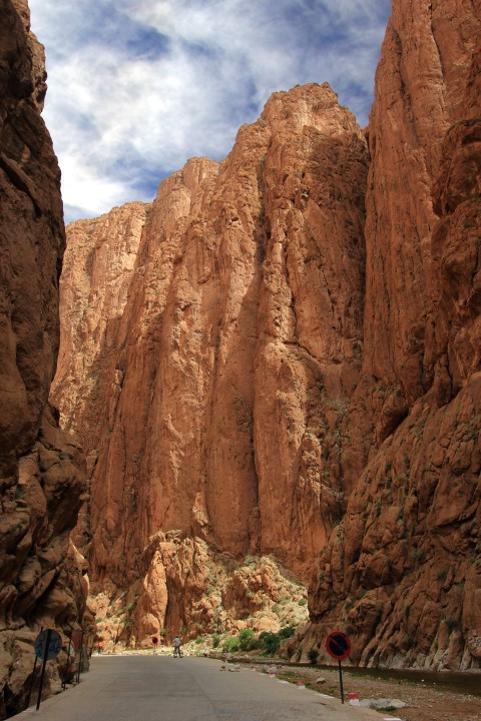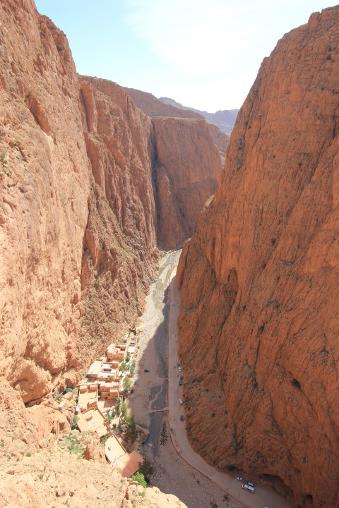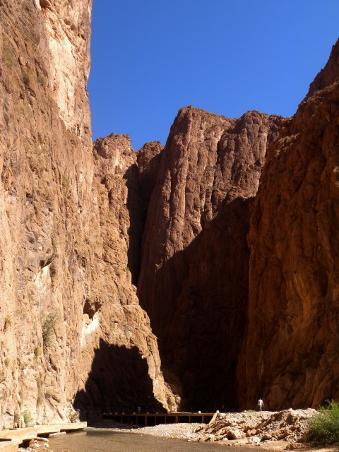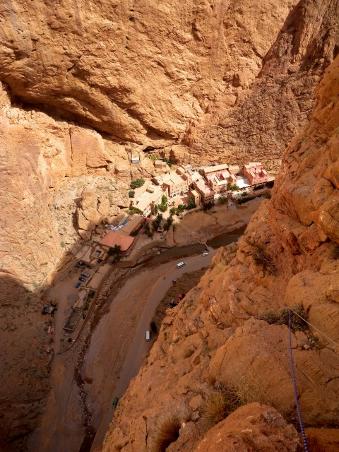Climbing in the Todra Gorge
SUMMARY
The Gorge is one of Morocco's premier sport climbing destinations, and is home to approximately 400 climbs, ranging from single-pitch top-ropes to 10-pitch adventures up the incredible walls of the narrow gorge. Fixed protection on popular sectors is generally excellent, and there are a good selection of long mixed sport/trad routes for those in search of more adventure.
WHEN TO GO
Reliable sunshine, pleasant temperatures, and a lack of rain give Todra a very favourable climate for the climber, making it an ideal escape during the winter months. The best times are September to November, or February through to May, although it is possible to climb in the gorge at any time of year.
GETTING THERE
Marrakech is the nearest international airport, and daily flights are available from throughout Europe. Bus services run from Marrakech to the town of Tinghir, which is located about 15km from the gorge entrance. See www.ctm.ma or www.supratours.ma for more information. Taxis can be hired from Tinghir to the gorge itself.
ACCOMMODATION
There are dozens of hotels, riads and guest houses available on the road between Tinghir and the gorge, as well as a handful of hotels within the gorge itself. Hotel Yasmina is located right in the heart of the climbing, within easy walking distance of most sectors. Hotel Mansour and Hotel La Vallee are popular options at the entrance to the gorge, or for those looking for a little more luxury, the Kasbah Lamrani in Tinghir is highly recommended.

MAPS
An overview map, showing the location of the Todra Gorge, as well as the other main climbing areas of Taghia and Tafraout, can be found here.
GUIDEBOOKS
Route information for the gorge has always been famously difficult to come by, but the new OAC pocket topo provides the best source of information. It is available from the Guidebook and Download Store.



First Impressions: Discovering Todra
You might have heard of Todra. Before the explosion of adventure-trad in Tafraout and the Anti-Atlas, and before Taghia's big walls started to emerge on the climbing radar, rock climbing in Morocco meant one thing: the Todra Gorge.
Sitting on the south side of the Atlas mountain range, this stunning limestone gorge was carved into the Atlas foothills by meltwater flowing down into the Draa Valley. Its sheer rock walls, in places barely more than 20m apart, rise 200 vertical metres from the narrow road which snakes its way through its shady depths. It's an impressive sight that draws tourists from all over the country, and for climbers it's an irresistible objective.
My first visit to the gorge was surrounded by scepticism. I'm a trad climber at heart, and the only sport climbing that I've ever really enjoyed was relaxing with a beer in the sunshine in between alpine ascents. We'd spent a week in Tafraout, but the time had come to see what all the fuss was about. What was the Todra Gorge? In fact, the first question was where was the Todra Gorge? We'd come to Morocco without a map, so navigation from Tafraout to Tinghir, at the entrance to Todra, would be based around some digital photographs taken in the offices of Tafraout Adventure, the day before. The eight-hour drive saw us leaving behind the perfect quartzite of Jebel el Kest, and heading out into a desert of limestone choss and unconsolidated rubble. Things did not bode well.
We passed through Tinghir and continued up the pot-holed road towards the gorge. Nothing but choss. This must surely be some kind of mistake? We were supposedly only a mile away from some of north Africa's best climbing, but still all we could see was rolling hills, interspersed with hideous crumbling outcrops. What had we done?
Soon enough, the rolling hills became steeper. Still chossy, but definitely steeper. The valley closed in, and took on a sort of dead-end kind of appearance. We could hardly wait to see what chossy horrors must surely lurk around the next corner, but as we rounded it we were hit in the face by one of the most awesome sights we could ever have imagined: the Pillier de Couchant, rising a thousand feet straight up from the road: magnificent, clean, and judging by the lack of scree, about as far removed from choss as you can get.
Its striking outline drew me like few other pieces of rock ever had, and in that one moment I vowed to climb the Couchant. It was the only 'sport' route that had ever had that effect on me, even if I was later to learn that it's not so much 'sport' as adventure. Our fears and suspicions were instantly dismissed, and we eagerly awaited the following morning, when we could set foot on the curiously brown limestone walls.
First, of course, we had to find accommodation, and the obvious choice lay just a hundred yards or so up the ravine - a strange little hostelry known as the Yasmina. From a climber's point of view it's hard to imagine a better situation, although my mountaineering instincts told me that this hotel was simply too close to the overhanging rocks above. All night I had terrible visions of rocks falling straight through the roof of our sparsely furnished room. Should we sleep with helmets on?
The hotel was powered by a noisy diesel generator that pumped out clouds of black exhaust, creating a dirty stain on the rocks above. At night time the generator was turned off, allowing for a peaceful night's sleep (assuming you're not thinking about the falling rocks), but being shown to our room by the light of a torch was something of a novel experience. Odd meal times, unfathomable menus, a curios lack of staff (and customers, for that matter), also added to the rather surreal memories. Any inadequacies of the accommodation, however, were more than made up for by the climbing, of which we had only the merest glimpse during our short stay in the gorge.
Before we had arrived here, three days seemed like long enough to explore a gorge that was, after all, little over a kilometre in length. Ever since that first view of the Couchant, of course, it was clear just how much climbing there was within walking distance of the Hotel Yasmina.
Over the course of three days, we sampled the superb variety of Todra climbing, taking in the very pleasant (though aggressively sharp) Plage Mansour, the very relaxed Petite Gorge, and a mandatory adventure up the full height of the main gorge wall. With all my reservations about sport climbing, I had to admit it: the climbing here was very good indeed. Roadside routes were thoughtfully bolted, the fixed gear was in good condition, yet the place had a wild, adventurous feel to it.
My only criticism of Todra was the manic hustle and bustle in the main gorge. Local traders would hang their stalls from the first bolts, and the incessant hard sell, of everything from paper doves to camel wool carpets, is enough to drive you up the wall... which it did quite literally in our case. Thankfully, once you get a pitch or two above the road, Todra reveals its true self. The tourists and traders, and all the haggling, are lost amongst the rugged, desolate landscape. The tiny stream, which surely could never have carved such a gargantuan feature, gets ever farther away, and as the day marches on, rays of sunlight try in vain to penetrate the shadowy depths of the gorge. The Yasmina, of course, is still, worryingly, onlya stone's throw away.
Descent from the longer routes is either by abseil, or, if you're lucky you get to top out onto the rim, from where the views are predictably epic. A fairly painless walk down rocky trails leads back to the gorge, for another surreal evening drinking illicit gin by the light of a headtorch. And so ended our first taste of Todra.
For the next few years, I still wasn't sure what to make of Todra. It was either a dirty, unattractive place with no booze and really weird hotels, or it was an irresistible adventure to which I must return. Confusing.
It was, however, that image of the Pillier du Couchant that sealed the deal, and earlier this year we found ourselves back in Tinghir, with four spare days and an open mind. The primitive accommodation within the gorge was exchanged for the relative luxury of a hotel room in town, where the convivial atmosphere and excellent food would provide altogether more comfortable surroundings.
As a warm-up we tackled the classic 'Arete Nord', an eight-pitch F5+, and the first route ever climbed in the gorge. Occasional bolts, long run-outs on easy ground, thought-provoking route-finding, and a couple of tricky steep pitches combined to produce a brilliant mountain day: never too difficult but always interesting.
And then came the Couchant. The hand-drawn topo, which was almost impossible to follow, implied that we should expect climbing up to about F6a+ or maybe F6b, and that we might need some nuts and cams to supplement the fixed gear. Armed with that information we picked our way across the stream (that was the walk-in... about 20ft of wobbly stepping stones) and located an assortment of bolts, pitons, and tat that hopefully marked the initial groove of 'La Classique', our chosen line of ascent.
The climbing was harder than I'd hoped, and it wasn't really sport climbing as such. Soaring dihedrals, draped in ancient rusty pitons and miscellaneous tat; mud-filled, flared cracks that wouldn't accept gear; but bolts just about where you needed them.
Big, long pitches took us ever higher above the constant flow of tourists through the gorge below, never too difficult, but sustained and continuously interesting. We'd heard everything from F6a to F6b, but E2 5c seemed a far more appropriate grade for a route such as this, and we were certainly glad of a good selection of cams and nuts, even on the 'better' bolted pitches. Higher up the route became indistinct. Pegs led off up dead ends, the angle eased, and numerous rap anchors served only to confuse. But this kind of adventure is what Todra does best, and before long we emerged triumphantly on a tiny platform, The Shoulder, from where a single immaculate pitch would lead us to the top. The setting was as good as any I had experienced, and although The Classique had only been 8 pitches in length, it certainly packed a lot into it's 300m or so of limestone cracks.
The descent down gentle slopes beneath the gorge entrance was little more than a pleasant stroll along a good path - which was remarkable given the striking verticality of the climb - and by the time the traders had finished packing up their stalls, and the tourist crowd had thinned, we were back at the car looking straight up in disbelief at where we had just climbed. This time there would be no need for illicit gin; instead we would enjoy the final night of yet another memorable trip in 4-star luxury in Tinghir.
I had been unsure about Todra, but now, having experienced the kind of incredible mix of adventure, sport, and trad that the gorge has to offer, there was no doubt. By the time we arrived back in the UK we were already planning our next trip... there was even more fun on the horizon...

Check out our complete range of local area maps, including the 1:50000 Outdoor Activity Maps as well as free downloads.

A full range of climbing guidebooks is available in our online shop, or you can read about what's available here.

We've got a bunch of free downloads to help you get the most out of your trip to the Anti-Atlas, including maps, updates, and topos.

Check out the latest new routes, or report your own first ascents in our online new route book.
